
ASIA--THE NEXT FRONTIER FOR HIV/AIDS:
Myanmar
Jon Cohen
Each country, let alone each continent, faces unique problems when confronting HIV and AIDS. Myanmar, Thailand, and Cambodia have the highest rates of HIV infection anywhere outside Africa. Nearby Vietnam has a lower HIV prevalence than the United States. Yet Vietnam has a raging problem with HIV and injecting drug use, and Cambodia does not. Myanmar and Thailand have much more similar epidemics, fueled by a potent mix of injecting drug use and commercial sex work, yet the governments that run these neighboring countries could hardly have reacted more differently. This collection of articles focuses on these four countries to spotlight both successes and worrisome trends in Asia, a continent that, without significant new prevention efforts, will have more HIV infections by 2010 than sub-Saharan Africa does today, some modelers predict. It is the first in an occasional series on HIV/AIDS in Asia, leading up to the XV International AIDS Conference in Thailand in July 2004.
Reporting for this series was supported in part by a fellowship to Jon Cohen from the Kaiser Family Foundation. Photographs are by Malcolm Linton.
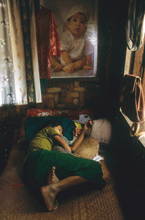
PHOTO BY MALCOLM LINTON
HLAING THAYAR, MYANMAR (BURMA)--San San Min strolls through a cluster of wooden shacks perched on stilts above former rice paddies. In one shack, which serves as a daycare and feeding center, dozens of rail-thin children mill about or rest on the bamboo-slatted floor. A clinician in her 50s who has a knowing smile, San San Min crosses a footbridge to another shack in which a few dozen men and women who also have frighteningly skinny limbs and necks lie on wooden beds. Unlike the children, they need more than hearty meals and a place to spend the day: They have AIDS, and these shacks are their home. This collection of huts is one of three clinics that San San Min runs for the Dutch branch of Médecins Sans Frontières (MSF) in this ramshackle town less than an hour from Yangon (Rangoon),* Myanmar's once glorious and wealthy capital city.
San San Min pauses to speak to a 33-year-old man sitting on a bed next to a prostrate, 28-year-old woman. A tank top hangs on the man's skeletal torso, revealing the bones of his rib cage and the scorpion tattoo that adorns his chest, a symbol of his stronger days when he worked in criminal intelligence. The woman keeps her eyes shut and clasps her hands over her stomach, tensing rigid with pain and then softly moaning. In an adjacent bed lies a 36-year-old woman, whose mother kneels on the floor, alternately fanning and feeding her ailing daughter. As the mother scoops spoonfuls of soup into her daughter's mouth, her gums badly swollen from candidiasis, she thanks San San Min: "If my daughter wasn't here, she would die."
Myanmar has one of the worst HIV problems in Asia. According to one controversial estimate, 3.46% of the adult population--some 687,000 people--is infected with HIV, a figure the government hotly disputes (see sidebar, p. 1652). The virus is spreading largely through injecting drug use and prostitution. And, as in many other poor countries, migrant workers--gem miners and loggers in Myanmar's case--are a major conduit into the general population. The staggering obstacles that those doing battle against AIDS face here are abundantly apparent at San San Min's clinic, which is poorly equipped and began treating a few patients with antiretroviral drugs only this spring--the first clinic in the country to do so. Yet, there are some modest successes: When the clinic opened 3 years ago, "there was a mean survival here of 6 months," says San San Min. "Now people are living about 2 years."
One difficult obstacle is the government. Myanmar is run by a military dictatorship that infamously crushed a democracy movement in 1988--and then changed the country's name from Burma. Its government has alienated much of the world, devastating this one-time Asian economic tiger. Not only does the military's iron-fisted rule isolate Myanmar and limit the willingness of wealthy countries to invest or offer assistance, it also tightly controls how its doctors both portray and respond to the country's HIV/AIDS epidemic. Many physicians and scientists fled the country following the 1988 crackdown (San San Min left before the turmoil and returned in 1993), all but destroying the research community. What's more, the government wraps itself in moral rhetoric that makes it difficult to acknowledge, let alone effectively help, those at the focal point of the epidemic: commercial sex workers and people who inject heroin. (Only Afghanistan grows more opium.)
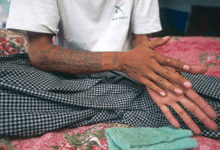
Hand in hand. Heroin injection and HIV infection unfortunately have afflicted many gem miners, such as this man.
PHOTO BY MALCOLM LINTON
Severe poverty compounds the problems. The cash-strapped government offers the barest of health care: A World Health Organization report in 2000 concluded that, of all its member states, only Sierra Leone had a health system that functioned worse than Myanmar's. "They've gutted their public health system," says Chris Beyrer, an HIV/AIDS epidemiologist at Johns Hopkins Bloomberg School of Public Health in Baltimore, Maryland, who has been a vocal critic of the government.
Myanmar rarely issues visas to foreign journalists, but after receiving several requests over 3 months, the Ministry of Health invited Science to enter and--accompanied by a government AIDS epidemiologist--tour the country to meet with public health officials, clinicians, scientists, and HIV-infected people. Scant resources exist at every level, and as with poor countries elsewhere, Myanmar relies heavily on various United Nations branches and international nongovernmental organizations such as MSF to help slow HIV's spread and care for those who have become infected.
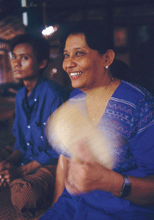
Hot spot. San San Min runs the Médecins Sans Frontières AIDS clinics in hard-hit Hlaing Thayar.
PHOTO BY MALCOLM LINTON
Although many people in the country speak critically of the government, no one Science met with did so openly. Several also stressed that the leaders have stepped up their resolve to deal with HIV/AIDS. "The government policy has changed significantly, and our people will find more and more services available," assures Hla Htut Lwin, head of the National AIDS Program. A new fund, supported by three European countries and organized by the Joint United Nations Programme on HIV/AIDS (UNAIDS), also promises to pump $21 million into battling the disease over the next 3 years, effectively tripling the amount now available. "This is the first time the AIDS effort here has had serious funds," says Eamonn Murphy, the UNAIDS country coordinator. That said, Murphy, Hla Htut Lwin, and others at the front still face an uphill battle.
Bare necessities
Nearly 90 years ago in Rangoon, the Pasteur Institute built a replica of its Paris headquarters, a French colonial edifice with grand arches and high-ceilinged, vast rooms. Today, the building houses Myanmar's National Health Laboratory, a bare-bones operation. The bacteriology lab grows samples in a wood-cased incubator that the Pasteur might have purchased not long after setting up shop. A huge cast-iron centrifuge, rubber belts dangling from it, lies broken in a hallway. In the virology lab, which is sweltering because the air conditioner broke, technicians hunt for HIV in blood donor samples sent in by hospitals. The samples arrive in old penicillin vials.
Khin Yi Oo, who heads the virology lab, acknowledges that it would be safer to transport blood in vacuum-sealed test tubes. "At present, we can't provide for all of the hospitals to use the test tubes," Khin Yi Oo explains. Although the lab has three machines that can test the samples for HIV antibodies, one sits on the floor, unplugged. "I can't find people to fix them," she says.
The National Health Laboratory does not have a flow cytometer, a machine that can automatically count CD4 cells: the main immune warriors that HIV selectively targets and destroys. Indeed, Khin Yi Oo and the other scientists here do not know of a single flow cytometer in Myanmar. Like most government employees, they have no access to the Internet, which the military monitors and tightly controls.
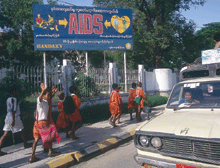
Mixed message. Avoid sex and drugs, says this AIDS billboard outside Mandalay's general hospital, making no mention of condoms or clean needles.
PHOTO BY MALCOLM LINTON
Although the National Health Lab collaborates with a Japanese team that analyzes the genetic signature of the HIV strains circulating in Myanmar, no sequencing machine exists here that would allow the scientists to do the work themselves. They also do not have a machine that can perform the polymerase chain reaction (PCR) assay, a molecular copier of DNA that has become as ubiquitous in modern biology labs as microscopes. A PCR machine would allow them to measure the amount of HIV in an infected person's blood cells, a key test for evaluating health status and responses to treatment.
Tin Nyunt, director of the National Health Lab, says that although his staff obviously needs equipment, that's not at the top of his wish list. "We need more training, capacity building of our young staff," he says. And that means more collaborations with foreign scientists. "Leave politics as it is for the politicians," urges Tin Nyunt. "We are the scientists. The people from the United States and elsewhere should know that we are working for the people, not the government."
Clinical tribulations
Just as the National Health Laboratory stands out for what it does not have, so, too, does the government-run clinic across the country in Mandalay that focuses on HIV and other sexually transmitted diseases (STDs). Kan Oo, who runs the clinic, points to an old centrifuge, similar to the one at the National Health Lab. "It should be kept in the museum," Kan Oo says. "It's older than me." The clinic also lacks something even more startling: patients.
On average, the clinic sees no more than 10 people a day, and at the moment, no one is here but staff. "It's a vicious circle," explains Min Thwe, an epidemiologist at the National AIDS Program, who served as Science's escort around Myanmar. Because of the limited resources, the clinic doctors must diagnose most STDs by symptoms rather than by tests for specific causative agents. "So it means there's no distinction between you and the private general practitioner, and you have fewer people using your clinic," says Min Thwe. "And then donors see this. Most STD clinics end up receiving less and less." Last year, Kan Oo says that the clinic, a part of Mandalay's sprawling general hospital complex, offered HIV tests to only 70 people. "We can't promote them that much because we don't have enough test kits," says Min Thwe.
Kan Oo oversees 17 STD clinics in the region, and the one with the most cases-- a telltale sign of where the most HIV exists--is in Myitkyina, the city closest to the country's jade mines. Remotely located and extremely difficult to reach during the rainy season, the mines have all the ingredients that HIV loves: large migrant populations, prostitution, and many injecting drug users (IDUs). No government clinic exists at any mine.
On the street outside the clinic, a large billboard, which shows men shooting up and a male-female couple surrounded by a heart, instructs people how to protect themselves from AIDS. "Avoid Drugs. Avoid Sex. Preserve Your Traditional and Cultural Values." The billboard avoids promoting the use of condoms and clean needles, two strategies that have proven most effective in derailing HIV.
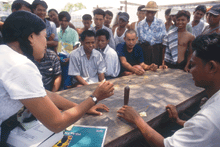
Rubber meets road. An educator with Population Services International raises the condom consciousness of truck drivers.
PHOTO BY MALCOLM LINTON
Mandalay does have a fairly progressive condom education and distribution program. At a truck stop this scorching morning, three dozen drivers gather around a young woman, who sits under a tree holding a wooden phallus and demonstrates to the men how to put on a condom properly. Population Services International (PSI), headquartered in Washington, D.C., dispatches educators such as this woman around the city each day to give demonstrations, answer questions, and distribute condoms and HIV information pamphlets. She hands a man a fresh condom and encourages him to put it on the phallus. The other drivers, many of whom have red-stained teeth from chewing beetle nut, giggle. "Don't be ashamed to go and get a condom," the woman says, straight-faced. "It's not against the culture."
Since 1996, PSI has worked in Myanmar, staging education sessions such as this one and selling condoms at a steep discount to grocery stores, street vendors, and other distributors, who then sell them for a few cents each. Yet political and cultural factors make it difficult for PSI to educate members of high-risk groups such as IDUs and commercial sex workers. Until recently, for example, a woman carrying a condom could be arrested as a prostitute. But Tin Oo, a physician who heads the Mandalay PSI program, says the government has become much more permissive about allowing PSI to promote condoms. The organization is now allowed to advertise condoms in magazines, and "we've just applied for permission to put up a billboard here," he says.
Sticking points
Shan state, a mountainous region bordering on China, Thailand, and Laos, grows more opium than any other region of Myanmar. In its capital, the pine-studded hill town of Taunggyi, psychiatrist Gyaw Htet Doe runs the Drug Dependency Treatment and Rehabilitation Unit. The patients' rooms at the 10-bed center have barred windows and sturdy steel doors that padlock shut. "Since this was constructed in 1975, we had this attitude, 'He's a drug user, lock him up, he's a bad guy,' " says Gyaw Htet Doe, shaking his head. "So the setting is almost like imprisonment. If I had the funds, I'd like to tear the place down and build something more in keeping with modern practices."
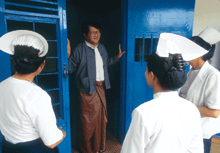
Barrier to treatment. Gyaw Htet Doe (in doorway) says the prisonlike facility used for their drug rehab program sends the wrong message to patients.
PHOTO BY MALCOLM LINTON
Myanmar has a schizophrenic view of IDUs that ignores most of the tenets of what's called harm reduction, a growing movement that treats addiction as a disease rather than a crime and strives to find practical ways to help addicts avoid dangers such as HIV. Although Myanmar offers treatment at centers like this one, anyone caught with drugs or even paraphernalia faces imprisonment. IDUs can purchase needles at drugstores in Taunggyi, but in more remote areas, they are not available. There are no needle distribution or exchange programs, both of which have proven effective at stopping HIV transmission. Gyaw Htet Doe also would like to offer methadone as substitution therapy for heroin. "It would be like a wish come true," he says. But the government considers methadone an illegal narcotic. Another law says that all drug users must be committed to units like this, meaning that no outpatient treatment technically can take place.
Gyaw Htet Doe and his staff of four nurses, who run the only drug treatment center for roughly 1.5 million people in southern Shan state, treat about 100 inpatients a year. "We're short in terms of manpower, expertise, funding--a whole lot of things," he says. Basically, all they can offer--to people who can afford to travel to Taunggyi--is detoxification, counseling for the patient and the family, and education. They don't track the recidivism rate, which he simply describes as "pretty high."
One of the inpatients, a 32-year-old HIV-infected man who has two children, has received treatment here 10 times. Like many other patients who come through the center, he started regularly visiting prostitutes when he worked in the nearby ruby mines in Mongshu, where, on a good day, he could earn up to $10. A government physician such as Gyaw Htet Doe earns $10 a month.
The patient says he smoked heroin for 2 years before injecting. "My friends told me it would be a higher high," he says, compulsively folding and unfolding a hand towel.
Forward thinking
Strong ties connect the fate of HIV/AIDS efforts in Myanmar--and indeed the fate of the country itself--to Aung San Suu Kyi, the leader of the National League for Democracy, the main opposition party. For much of the past 15 years, the government has kept Suu Kyi under house arrest, even after her party's landslide victory (never observed by the military) in the 1990 parliamentary elections and her award the following year of the Nobel Peace Prize. Suu Kyi long has discouraged tourism and cautioned foreign governments not to aid the country that she and her supporters still call Burma, arguing that the outside money helps prop up the regime.
Following her release from house arrest in 2002 and much talk about reconciliation between the government and the National League for Democracy, Suu Kyi had what many perceived as a change of heart about foreign investments with regard to HIV/AIDS. She met with several outside groups working on the problem, including San San Min and her patients in Hlaing Thayar. She effectively gave her blessing to the two most ambitious aid packages then on the table: the new fund organized by UNAIDS, and an attempt by scientists from the U.S. Centers for Disease Control and Prevention (CDC) to establish a far-reaching collaboration.
The forward momentum has suffered some serious blows. In December 2002, the U.S. government suddenly and inexplicably put the CDC project in the deep freeze (see sidebar, p. 1654). Then on 30 May, the Myanmar government drew international criticism--and new sanctions--from the United States and many other countries when it put Suu Kyi under "protective custody." Her detainment came after a deadly incident that the government described as a brawl between Suu Kyi's supporters and a mob that had gathered to demonstrate against a rally she planned to hold; the U.S. State Department, which investigated the incident, described it as a "premeditated ambush" on Suu Kyi's motorcade by "government-affiliated thugs." Politically, the incident and Suu Kyi's arrest "crushed everything moving forward," says Beyrer of Johns Hopkins.
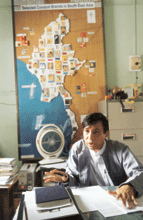
Mapping a strategy. National AIDS Program director Hla Htut Lwin says Myanmar badly needs more collaboration with scientists from other countries.
PHOTO BY MALCOLM LINTON
Still, groups that determinedly separate politics from health promise to continue their efforts to improve the country's feeble and woefully insufficient response to HIV/AIDS. The most far-reaching project, the Joint Programme on HIV/AIDS, offers a detailed plan that aims to improve care and treatment for infected people over the next 3 years and to significantly expand campaigns to prevent transmission from sex and injecting drugs. "We're trying to initiate a coordinated program in a country that has had a piecemeal approach," says Murphy of UNAIDS.
The plan, which includes research to evaluate the impact of specific interventions, addresses several touchy issues head-on. Harm-reduction programs for IDUs, it says, should include substitution drugs such as methadone and easy availability of clean injecting equipment. Condoms should become more widely available to sex workers, youth, and even prisoners. Voluntary counseling and testing for HIV--a key prevention strategy that the government now allows only at its clinics--should become widely available in both public and private clinics. "It could be a great change," says Hla Htut Lwin.
UNAIDS has organized a fund to support the $51 million project, which to date has raised $21 million, the bulk of it coming from the United Kingdom. Other donor money already committed to HIV/AIDS projects in Myanmar totals about $10 million. But even "combining all the available resources, the gap is still huge," cautions Hla Htut Lwin. "And even if we have more money, we can't move forward fast enough without more collaboration."
A number of people working in the country stress that Myanmar must act now, because the older generation of scientists and doctors such as Hla Htut Lwin had better training than their younger colleagues do. The quality of domestic universities has steadily eroded, and opportunities to study abroad have steeply declined. "The country currently has the technical capacity to do the job," says Murphy. "We have a window of opportunity." The other, more obvious reason for Myanmar to quickly step up its attack on HIV: The virus is walloping its population. "Time is running out," says Myat Htoo Razak, an AIDS researcher and clinician who left the country in 1989 and now works in Thailand. "I have tremendous respect for people working inside Burma," he says, but they "are fighting fire rather than preventing fire."
And they are trying to contain the fire with water pistols. Consider that only in September last year did MSF receive the government's blessing to begin a pilot study to treat 100 AIDS patients in Hlaing Thayar with antiretroviral drugs, the first such program in the country. The program began treating people this April. In a shack located between the children's feeding center and the room filled with adults who have late-stage AIDS, Nilar, a 31-year-old woman whom MSF has hired as a peer educator, sifts through patient charts, looking for eligible patients. Nilar, the mother of a 12-year-old girl, has AIDS herself and has now started to receive anti-HIV drugs through the MSF pilot study. "I compare it to winning the lottery," says Nilar.
As much as this project means to Nilar and a few lucky others, San San Min puts it into stark perspective. "There's some kind of hope here, but we have to be clear," she says. "This is a pilot program for this township." Myanmar has tens of thousands of people with AIDS who need treatment now. In May 2003, Nilar was one of only 13 people in the country other than the wealthy few who can afford their own medicine who have begun to receive life-extending anti-HIV drugs.
That, unfortunately, reflects a tragic reality for HIV-infected people in Myanmar: This resource-rich country, once the envy of its neighbors, has a withered, skeletal medical and research infrastructure that itself appears to have a case of late-stage AIDS. And the prognosis, at least for the near future, remains grim.
* Burma's military rulers changed the country's name to Myanmar and changed the names of many cities. The former names of familiar cities--the only names recognized by the military's opponents--are given in parentheses.
Volume 301,
Number 5640,
Issue of 19 Sep 2003,
pp. 1650-1655.
Copyright © 2003 by The American Association for the Advancement of Science. All rights reserved.
|